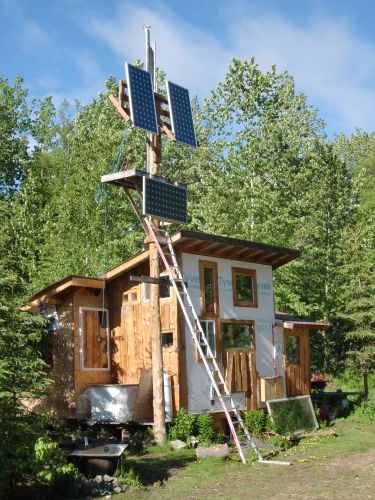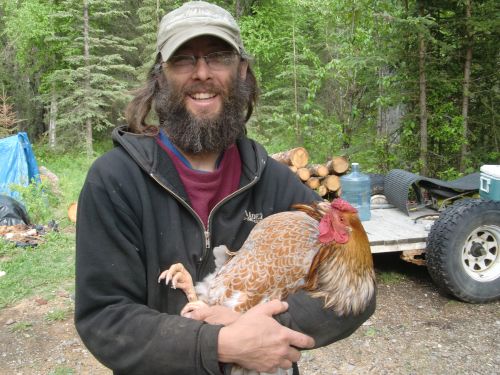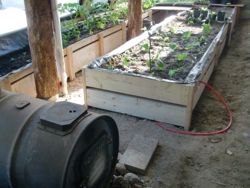I just spent a week in Chickaloon, AK with my sister Allie and her husband Jed on their farm that sits between the Chugach and Talkeetna Mountains in the Matanuska Valley, about 1.5 hours northeast of Anchorage. These two (and their dog Dillon and 25 chickens) are truly living a sustainable lifestyle as they live off the land of their solar powered homestead. They have built everything on the land by hand including milling most the lumber themselves. The homestead they have created is truly impressive and consists of the main house (pictured below), two sheds, an outhouse, a salmon smoker, a couple chicken houses, a seed starting house, the new greenhouse, all the farm beds for growing food and of course a sauna.
 Jed and Allie’s house, which was the first structure they built on their homestead.
Jed and Allie’s house, which was the first structure they built on their homestead.
Now, you might not think that Alaska would be a very good place to be a farmer. In fact they got tons of snow in the Matanuska Valley and hardly any day light in the winter, but once the snow melts, they have much longer days and the crops can “catch up” after a later start to their growing season. They grow enough food to feed themselves for the whole year. Their root cellar, along with canning and fermenting, are key in allowing them to preserve their food year round. They also sell their yummy veggies at the Spenard Farmer’s Market and to the Mooses Tooth Restaurant in Anchorage, as well as running a small CSA (Community Supported Agriculture).
 The new greenhouse (right), two hoop houses (left) and upper beds.
The new greenhouse (right), two hoop houses (left) and upper beds.
 The lower farm fields
The lower farm fields
Salmon
The other major food source for Allie and Jed come from hutting and fishing. They hut moose and fish for salmon. When I arrived they had just returned from the Copper River with some fresh fish. They freeze, can and smoke the salmon so they can eat it throughout the year.
 After carefully filleting the fish, the rest will be used to make dog food. They don’t let any of the fish go to waste.
After carefully filleting the fish, the rest will be used to make dog food. They don’t let any of the fish go to waste.
 I was also treated to some fresh salmon for dinner!
I was also treated to some fresh salmon for dinner!
Chickens
Jed and Allie also eat a lot of eggs laid by their family of chickens. The chickens roam freely around the property pecking at the ground for seeds and bugs. There are fences around all the garden beds so the chickens don’t eat the crops.
 At night they come in to roost in the insulated chicken shed
At night they come in to roost in the insulated chicken shed
 Jed about to introduce the new rooster to the flock
Jed about to introduce the new rooster to the flock
The Greenhouse
The growing season is short in Alaska, so as farmers, Allie and Jed are always looking for ways to extend their season and provide a warmer environment for warm weather crops to grow. This past winter, their major project was building a greenhouse. They started all their crops in the greenhouse and when I arrived it was time to plant the crops such as tomatoes, cucumbers, beans and peppers into the beds.
 The greenhouse is heated by a wood stove.
The greenhouse is heated by a wood stove.
 The red pipe will be filled with hot water that will run through cooper coils around the stove into a barrel and then through the soil beds to keep the plants warm.
The red pipe will be filled with hot water that will run through cooper coils around the stove into a barrel and then through the soil beds to keep the plants warm.
Soil Nutrients
When I was up in the Arctic, we were looking at nutrient movement on the hillslopes. It was interesting to hear Allie and Jed talk a lot about the same nutrients I was looking at in the Arctic: Nitrogen and Phosphorus. They are constantly monitoring their crops and adding organic soil additives to keep the nutrient and mineral balance correct. Their crops look truly amazing!
 Allie harvesting some greens for market.
Allie harvesting some greens for market.
Spending a week on the farm with my hands in the dirt was a great way to unwind from my time in the Arctic, before I head back home. And thanks to Allie and Jed for sharing their amazing home grown food with me!

